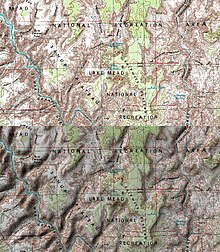Terrain cartography: Difference between revisions
few tweaks to add and position new example image |
→Hachures: expand text a bit (pinched from main article) |
||
| Line 25: | Line 25: | ||
[[Image:Dufour-karte-bern_1-880x803.jpg|thumb|left|Dufour map of Bern (1907); this is a shaded hachure map.]] |
[[Image:Dufour-karte-bern_1-880x803.jpg|thumb|left|Dufour map of Bern (1907); this is a shaded hachure map.]] |
||
{{main|Hachure map}} |
{{main|Hachure map}} |
||
'''Hachures''' are an older mode of representing relief. They show orientation of |
'''Hachures''' are an older mode of representing relief. They are a form of shading, although different from the one used in shaded maps. They show the orientation of slope, and by their thickness and overall density they provide a general sense of steepness. Being non-numeric, they are less useful to a scientific survey than contours, but can successfully communicate quite specific shapes of terrain. |
||
Hachure representation of relief was standardized by the Austrian topographer Johann Georg Lehmann in 1799. |
|||
==Hill profiles== |
==Hill profiles== |
||
Revision as of 13:06, 10 October 2008

Terrain or relief is an essential aspect of physical geography, and as such its portrayal presents a central problem in cartography, and more recently GIS and 3D Visualization.
The most obvious way to depict relief is to imitate it at scale, as in molded or sculpted solid terrain models and molded-plastic raised-relief maps. Because of the disparity between the horizontal and vertical scales of maps, raised relief is typically exaggerated.
On flat paper maps, terrain can be depicted in a variety of ways, outlined below:
Contour lines

Contour lines (or isohypses) are isolines showing equal elevation. This is the most common way of numerically showing elevation, and is familiar from topographic maps.
Most 18th and early 19th century national surveys did not record relief across the entire area of coverage, calculating only spot elevations at survey points. The United States Geological Survey (USGS) topographical survey maps included contour representation of relief, and so maps that show relief, especially with exact representation of elevation, came to be called topographic maps (or "topo" maps) in the United States, and the usage has spread internationally.
Hypsometric tints

Hypsometric tints are a variant on contour lines. They depict ranges of elevation as bands of color, usually in a graduated scheme.
The Scottish map firm John Bartholomew and Son is credited with popularizing the technique, and its color scheme has become conventional: dark greens at low elevations, progressing through yellows and ochers, to browns and then grays and white at the highest elevations.
Hypsometric tinting in maps is often accompanied by bathymetric tinting in oceans, which indicates depths using a similar method
Hachures

Hachures are an older mode of representing relief. They are a form of shading, although different from the one used in shaded maps. They show the orientation of slope, and by their thickness and overall density they provide a general sense of steepness. Being non-numeric, they are less useful to a scientific survey than contours, but can successfully communicate quite specific shapes of terrain.
Hachure representation of relief was standardized by the Austrian topographer Johann Georg Lehmann in 1799.
Hill profiles

The most ancient form of relief depiction in cartography, hill profiles are simply illustrations of mountains and hills in profile, placed as appropriate on generally small-scale (broad area of coverage) maps. They are seldom used today except as part of an "antique" styling.
Shaded relief

bottom: the same map with sun shading
Shaded relief, or hill-shading, simulates the cast shadow thrown upon a raised relief map, or more abstractly upon the planetary surface represented. The conventional angle of the light source for such models is from the northwest (i.e. normally from the upper left corner of the map). This makes most depictions in the northern latitudes non-representative of solar light/shadow patterns, and is done conventionally to avoid Multistable perception illusions (i.e. crater/hill confusion). Because the viewer is looking at a printed or displayed image, the default assumption is that light is coming from above.
Traditionally drawn with charcoal, airbrush and other artist's media, shaded relief is today almost exclusively computer-generated using digital elevation models, with a resulting different look and feel. Much work has been done in digitally recreating the work of Swiss master Eduard Imhof, widely regarded as the master of manual hill-shading technique and theory. Imhof's contributions included a multi-color approach to shading, with purples in valleys and yellows on peaks.
The use of illumination and shadow to produce an appearance of three-dimensional space on a flat-surfaced map closely parallels the painting technique known as chiaroscuro.
Physiographic illustration
Pioneered by Hungarian-American cartographer Erwin Raisz, this technique uses generalized texture to imitate landform shapes over a large area. A combination of hill profile and shaded relief, this style of relief representation is simultaneously idiosyncratic to its creator and very useful in illustrating geomorphological patterns.
More recently, Tom Patterson created a computer-generated physical map of the United States using Erwin Raisz's work as a starting point.
Forums and associations
Portrayal of relief is especially important in mountainous regions. The Commission on Mountain Cartography of the International Cartographic Association is the best-known forum for discussion of theory and techniques for mapping these regions.
